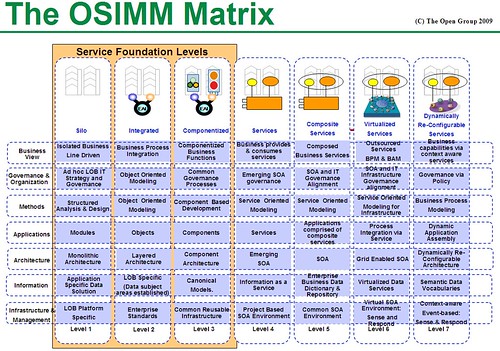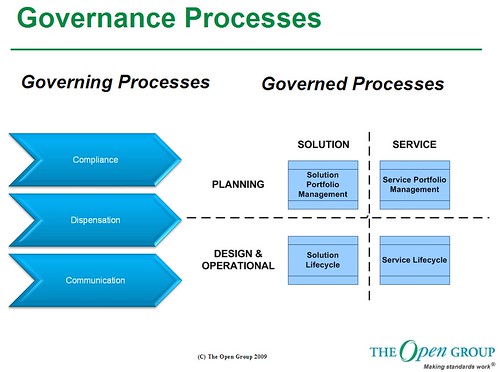8pm
We’re just getting started with the Process Design Slam: one of the face-to-face sessions that make up the collaborative design process that started a couple of months ago on the Design Slam wiki. Marilyn Pratt has identified the six groups that will each work on their part of the design, collaborating between groups (a.k.a. poaching talent) as required, and even bringing in people from the Hacker Night and Business Objects events going on in the same area.
- Business Use Case, led by Greg Chase
- Collaborative Modeling, led by David Herrema
- Business Rules, led by James Taylor
- Service Implementation, led by John Harrikey
- BPM Methodologies, led by Ann Rosenberg
- UI and Dashboards, led by Michelle Crapo
Right now, everyone has formed into initial groups based on their interests, and is having some initial discussions before the food and beer arrives at 8:30. Since there was an initial story and process model developed by the online community, everyone is starting at something close to a common point. Participants within a group (and even the leaders) could change throughout the evening.
By the end of the night, each team will have created a story about their work, and give a 5-minute presentation on it. The story must include additional media such as video and images, and in addition to the presentation, it must be documented on the wiki. Each story must also be related to the output of the other teams – requiring some amount of collaboration throughout the evening – and include pointers on what worked and didn’t work about their process, and what they would do differently in the future.
At that point, the judging panel, which includes me plus Marc Rosson, Uli Scholl, Ann Rosenberg and Dick Hirsch, will render our judgment on the creations of the groups based on the following criteria:
- Clarity and completeness of the story on the wiki, particularly if it could be understood without the presentation.
- Creative use of media.
- How well this story ties into the overall storyline of the night.
- The social process that was used to create the story.
I’m floating around between groups to listen in on what they’re doing and some of their initial thoughts.
8:30pm
Beer o’clock. The Business Rules team is still deep in conversation, however, and Business Use Case comes over to them to ask for help in bringing the business rules and business use case together. Business Use Case outlines the actors that they have identified, and the high-level business processes that they have identified in addition to the initial business process of bringing new consumer-producers online.
9pm
BPM Methodologies has a much wider view than just this project: developing methodologies that can be used across (SAP) BPM projects, including assessing the business process maturity of an organization in order to determine where they need to start, and identifying the design roles. In the context of the design slam, they will be helping to coordinate movement of people between the teams in order to achieve the overall goals.
9:30pm
Service Implementation – viewed by groups such as Business Use Case as “the implementers” – have revised the original process map from a service standpoint; looking at the services that were required led to a process redesign. They are using the Composite Designer to model the service orchestration, including the interfaces to the services that they need and external services such as FirstLook, an wind assessment service based on location data. In their service orchestration process, they assume that the process is initiated with the data gathered from a user interface form, and they focus primarily on the automated process steps. Ginger Gatling doesn’t let me leave the table until I tell them what they have to do to win; I advise them to update the wiki with their story.
9:50pm
The Collaborative Modeling group is modeling the business process using Gravity, online with a couple of participants in Europe. This is a process model from a business standpoint, not an executable model; there is no concept of the linkage between this and what is being done by the Service Implementation team. I suggest that they should head over there to compare processes, since these should (at some level) just be different perspectives on the same process.
10pm
Business Use Case is identifying the necessary processes based on their earlier collaboration with Business Rules: this has given them a good understanding of business case, goals and incentives. They’re considering both human and automated usages, and have fed their results to the UI, Business Rules and Collaborative Modeling teams.
10:10pm
Business Rules states that they’ve had to gather information from numerous sources, and the challenge is to sequence it properly: data is captured by the UI, but is driven by the Business Use Case. They didn’t work with the Collaborative Modeling group directly, but there are links between what they do and what’s happening in the process. They’re also interested in using historical usage data to determine when to switch consumers between usage plans.
10:20pm
UI and Dashboards managed to recruit a developer who is actually coding some of their interfaces; they were visited by many of the other groups to discuss the UI aspects, since the data gathered by the UI drives the rest of the process and rules, and the data generated by the process drives the dashboard interfaces. They feel that they had the best job since they could just be consumers and visualize the solutions that they would like to have.
10:35pm
Presentations start. Marilyn Pratt is being the MC, and Greg Chase is wrangling the wiki to show what has been documented by each of the groups. Half of the Service Implementation team just bailed out. I have to start paying attention now. Checking out the wiki pages and summarizing the presentations:
- Business Use Case worked with the UI, Collaborative Modeling and Business Rules teams, since those teams required the business use cases in order to start their work. They developed a good written story including cultural/social background about the fictional city where the power generation plan would go into effect. They defined the roles that would be involved (where one person could take on more than one role, such as a consumer that is also a producer), and the processes that are required in order to handle all of the use cases. They did not use any presentation/documentation media besides plain text.
- BPM Methodologies had excellent documentation with the use of graphics and tables to illustrate their points, but this was a quite general methodology, not just specific to this evening’s activities. They worked briefly with the other groups and created a chart of the activities that each of these groups would do relative to the different phases in the methodology. I found the methodology a bit too waterfall-like, and not necessarily a good fit with the more agile collaborative methods needed in today’s BPM.
- Business Rules focused on the rules related to signing up a new user with the correct pricing plan, documenting the data that must be collected and an initial decision table used to select a plan, although no graphics or other non-text media. They worked with the Business Use Case team and the UI team to drive the underlying business use cases and data collection.
- UI and dashboards created the initial mockups that can be used as a starting point for the design slam in Vienna in a couple of weeks. They worked with Business Rules and Business Use Case in order to nail down the required user data inputs, and what is required for monitoring purposes, and included some great graphics of the monitoring dashboards (although not the data collection form).
- Collaborative Modeling used Gravity (process modeling in Google Wave) not just for modeling with the group around the table, but also with participants in Germany and the Netherlands. They included photos of the team as well as screen snaps of the Gravity Wave that they created, although the text of the story documented on the wiki isn’t really understandable on its own. I’m not sure that they spent enough time with other groups, especially the Service Implementation group.
- Service Implementation talked to the Business Rules and UI teams to discuss rules and data, but felt that they were running blind since there wasn’t enough of the up-front work done for them to do any substantial work. They used placeholders for a lot of the things that they didn’t know yet, and modeled the service orchestration. The documentation in the wiki is very rudimentary, although includes the process map that they developed; it’s not clear, however, how the process model developed in Collaborative Modeling relates to their map.
11:30pm
And now, on to the judging – I’ll write up the critique and results in a later post.


